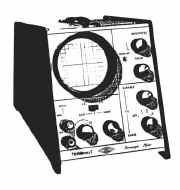|
Telequipment Serviscope Minor Oscilloscope
Manuals
also available for the following models :-
S22, D31, D31R, S31, S31R, D32,
S32A, S32AR, D43,
D43R, S43, D51, S51,
D52, S52, D54, D54R,
D56, D61,
D61A, DM63, DM64, D65, D66,
D67, D67A, D80, D83,
D1010, D1011, D1015, D1016 & Serviscope Minor.
Click
Here
GENERAL DESCRIPTION
CATHODE RAY TUBE
The 2 & 3/4 in diameter cathode ray tube operates at 600 volts overall, giving a bright trace over the whole of the working area of 5 x 5 cm. Each division is 0.5 cm.
A green filter improves the contrast under conditions of high ambient light.
VERTICAL DEFLECTION AMPLIFIER (Y AXIS)
The amplifier is d.c. - coupled to the Y deflection plates. It has a sensitivity greater than 100 mV/division and a band-width from d.c. - 30 kHz (-3dB).
The input gain control varies the signal level from 100 mV/div. to 50 V/div.
The input impedance is 1 M ohm shunted by approximately 30 pF.
SWEEP CIRCUIT (X AXIS)
The sweep generator is a triggered Miller run - down circuit providing good linearity. Three preset sweep speeds are provided, ranges 1, 2 and 3. These are approximately 10
ms/div. 1 ms/div. and 100
u/div. A variable control provides continuous overlap between the ranges, giving a total range of sweep speeds from 100 ms to 100
u/div.
In the OFF position a stationary spot is produced. The Variable control then acts as a shift control and so allows the
spot to be cantered. X input sockets at the rear of the instrument allow external signals to be displayed. The sensitivity is approximately 1.1 V/div. and the frequency response
2 Hz - 50 kHz (-3dB). The input impedance is 1 M ohm shunted by approximately 100 pF.
TRACE BLANKING
The blanking waveform from the sweep generator is a.c.- coupled and d.c.
- restored, so giving uniform brightness at all sweep speeds.
TRIGGERING
The oscilloscope triggers automatically from an applied signal. No external adjustment is provided. In the absence
of a signal the sweep free runs at about 10 Hz.
COOLING
The Serviscope Minor is cooled by convection. Air enters at the rear of the bottom of the
instrument, flows past the valves and other hot components and out at the slot at the
top front of the instrument. Do not obstruct the air F low in
any way.
|

|


